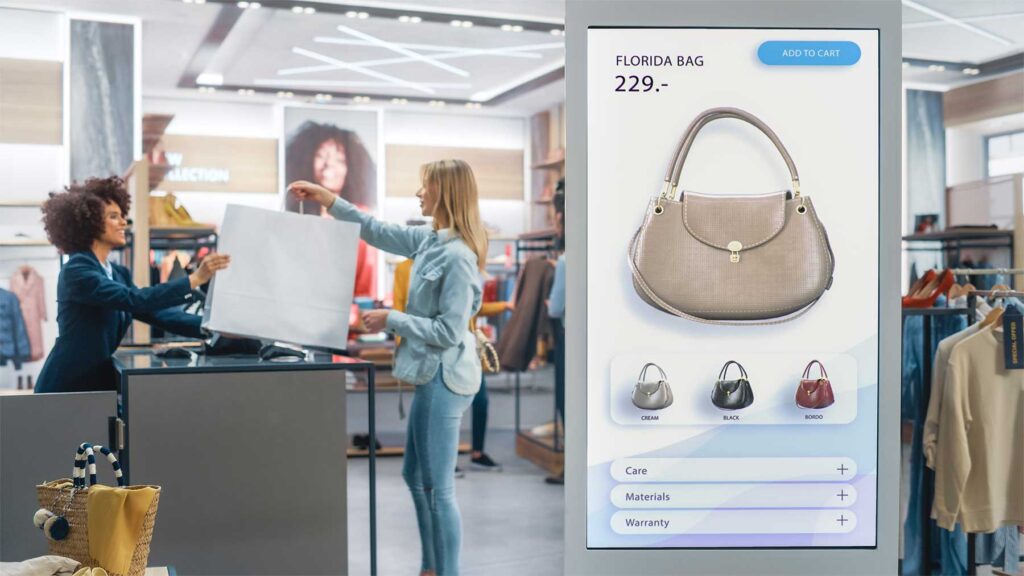Self-service tech and skilled associates could help ease retail holiday headaches
Convenience is key in retail. That means, the less friction customers encounter, the better. When most shoppers were reluctant to spend time in-store early in the pandemic, retailers leveraged technology to offer online ordering and curbside pickup. And while these tactics were once differentiators, they’ve quickly become commonplace. They also limit opportunities to build brand loyalty and capture upsell opportunities.
With lockdowns over and society reopened, customers have been returning to stores, leading to declining e-commerce sales from their 2020 highs. Amazon—the world’s biggest internet marketplace—recorded a 12.5% increase in brick-and-mortar sales in Q2 and 27% of online sales were fulfilled at a physical store in 2021, up from 21.7% in 2020.

Increased footfall may sound great for retailers, but it also presents a big problem, especially since the holiday shopping season in North America started early and looks to provide new challenges. Inflated prices mean customers are on the lookout for deals and new brands to try out—if the price is right.
Returning customers are being confronted with stores that are short-staffed, as frontline businesses continue to struggle with labor shortages, which means long lines, unstocked shelves and new employees who know little about their company’s products and services. If retailers can’t fix staffing problems fast, customers will find new ways to spend their time and money this year.
Rethinking the checkout line
It’s a classic two birds, one stone scenario. How do you improve the customer experience while operating with less people? Use technology to smooth over the biggest friction point in any retail store: the checkout line.
Retailers are in the midst of a self-service experiment that will determine the future of in-store shopping. 7-Eleven introduced mobile checkouts as part of their loyalty program. Dollar General and Albertsons are piloting self-checkout-only stores. H-E-B is testing technology that scans a customer’s basket without requiring items to sit on a conveyor belt. Even Disney deployed self-checkout in their theme park merchandise locations.
Self-checkout may be new to retail, but automation has a long history of improving customer convenience while reducing a business’ staffing requirements. However, the human impact of self-service technology is often misunderstood.
The human side of self-service
Your paycheck is directly deposited into your account, which you can monitor online. You can drive up to an ATM to withdraw cash for those specific moments when it’s required. Bank visits are a rarity for most people nowadays.
But, when you do make a visit, it’s likely for something more complicated than a standard withdrawal. It’s an opportunity for the bank to differentiate itself and build customer loyalty. It’s less transactional and more relationship-focused. But to make this version of the bank experience work, employees must have advanced knowledge of financial products and services. Otherwise, there won’t be a second visit.
The same is true in retail self-service. The checkout is often the only place where customers interact with employees. It may be a quick interaction, but it’s also a chance to establish a human relationship. Remove this moment, and you’re left to compete solely based on product availability, price and convenience and since the same products, comparable prices and self-service tech is available at other stores, you need a reason why a customer shops at yours.
Essential skills that make tech successful
This kind of tech shifts the moments that matter away from the cash wrap into other parts of the shopping experience. Rather than relying on scripted conversations with cashiers (“Did you find everything you were looking for?”), retailers must empower associates with the knowledge and skill to create authentic interactions that raise CSAT scores and bring customers back.
Implementing a great self-service experience is about more than technology. It also requires prioritizing onboarding and continuous training for the frontline associates who will play a critical role in the technology’s success and may have limited experience, skills and product knowledge.
It’s imperative that retailers create a modern learning strategy that prioritizes essential skills, including:
- Customer service skills: Associates need emotional intelligence to tell the difference between a customer who could benefit from assistance and one who wants to be left alone. Associates should be able to manage their assigned tasks (stocking shelves, rotating products, etc.) while also acknowledging customers and offering their support.
- Product knowledge: Associates should be able to educate customers on products, answer questions and make informed recommendations as part of upsell opportunities. A solid understanding of the company loyalty program and info about any special offers and promotions should be promptly offered to help customers maximize the value of their visit.
- Process knowledge: Associates need to understand the entire customer experience—both in-store and online. That means being ready to assist customers with complex processes, like online orders, returns and refunds, and make sure the entire shopping experience is as easy as self-service checkout.
- Technology skills: Associates must be ready to educate customers on the technology and provide assistance for those who are unable to use it on their own. They should also be capable of stepping in to fix minor technical issues when they inevitably happen, while delivering a satisfying customer experience.
We don’t know exactly how the self-service technology experiment will play out in retail. Chances are good that it will become another component of the modern omnichannel shopping experience as the e-commerce-driven holiday season marches steadily towards December. What remains constant is that frontline workers have an essential role to play. Yes, the jobs may change and staffing levels may adjust. But their human touch is precisely the differentiator that will keep your stores from becoming just another ATM.
